Menu
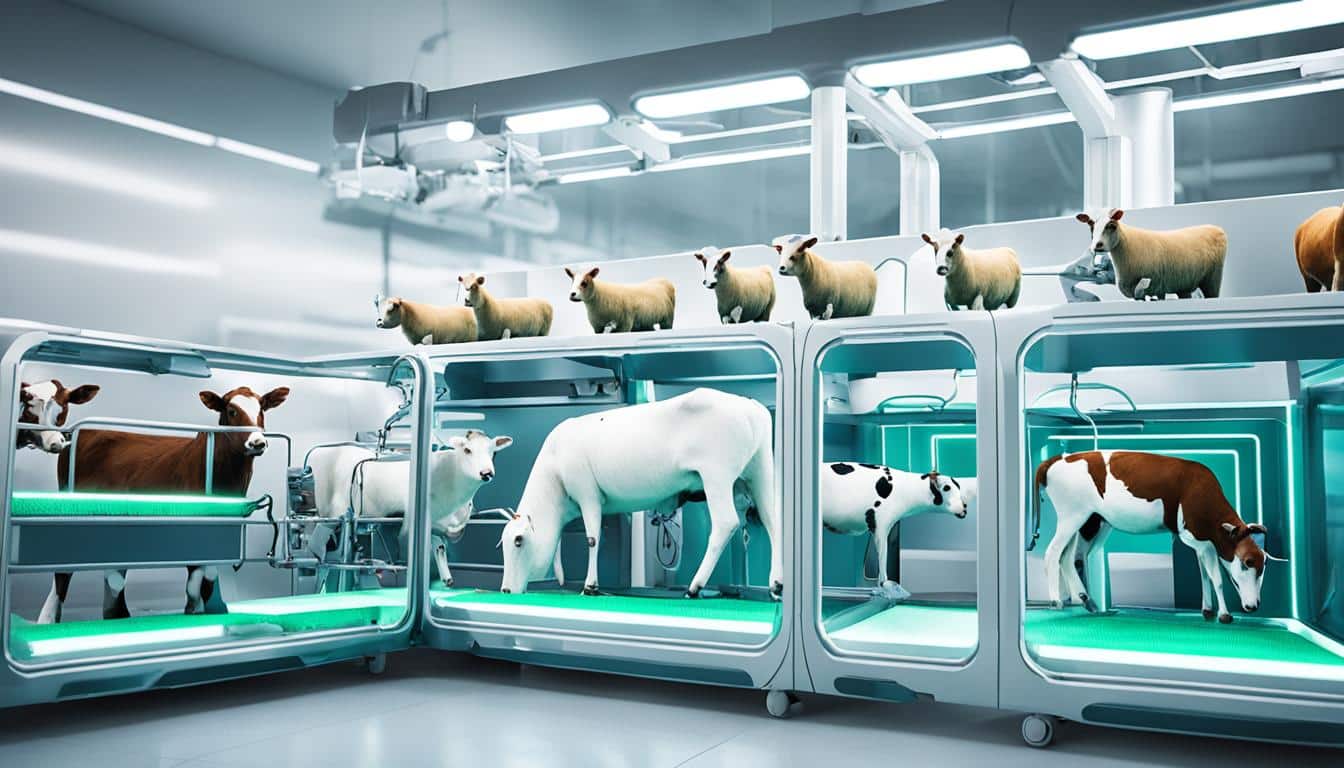
Do you know that livestock production makes up about 40% of global agricultural GDP, as per the FAO? This shows how important livestock farming is around the world. In 2020, meat production hit 335.4 million tons, adding a huge USD 1,329.1 million to the economy.
The future of livestock farming is bright. It’s expected to increase by 10.7% each year, reaching USD 2,445.9 million by 2028. This rise is because of new digital technology and livestock automation. With a growing world population and the need to fight climate change and other environmental issues, the farming of livestock must become more sustainable and ethical.
Automation and robotics are key in offering smart, tech answers to challenges facing us. By transforming how we look after livestock with robotics, we can be more productive, make animals happier, and cause less harm to the environment.
Robotics in livestock farming is changing farming for the better. It’s making agriculture more efficient and sustainable. With the world’s population growing, the need for food is increasing fast. Old ways of farming, which used lots of people to do the work, can’t keep up. This is where robots step in, helping meet the food demand efficiently.
Before, people did all the work on farms – like feeding animals and keeping them healthy. But with more farm animals to look after, and a shortage of farm workers, things are getting hard. The costs of farming keep going up. The environment is changing too, which means farming needs to be more sustainable.
Robots are becoming the new farm helpers, with the world spending lots of money on them. By 2022, over $6 billion was spent on farming robots. This number is expected to reach $18 billion by 2030. It shows that farming is moving towards Smart Farming Robotics quickly.
Looking after traditional farming methods isn’t easy. There aren’t enough people to take care of the many farm animals. Big farms find it hard to protect the environment and prevent diseases. Old farming tools and ways can be risky. This is why we need new, safer ways.
Robotics in Livestock Care helps by offering better ways to take care of animals. With things like wearable tech for animals, we can watch their health all the time. This has a big impact on how we keep animals safe and healthy.
The EU and US are supporting the use of robots in farming through programs and funding. This support encourages sustainable farming with the help of robots. These robots don’t just make farming more efficient. They also improve how we care for animals and the environment.
The agricultural sector is facing new challenges due to its growing complexity worldwide. Livestock farming, in particular, is feeling the pressure. By 2050, the world’s population could reach 9.5 billion. To meet these demands, farming must find new, innovative solutions.
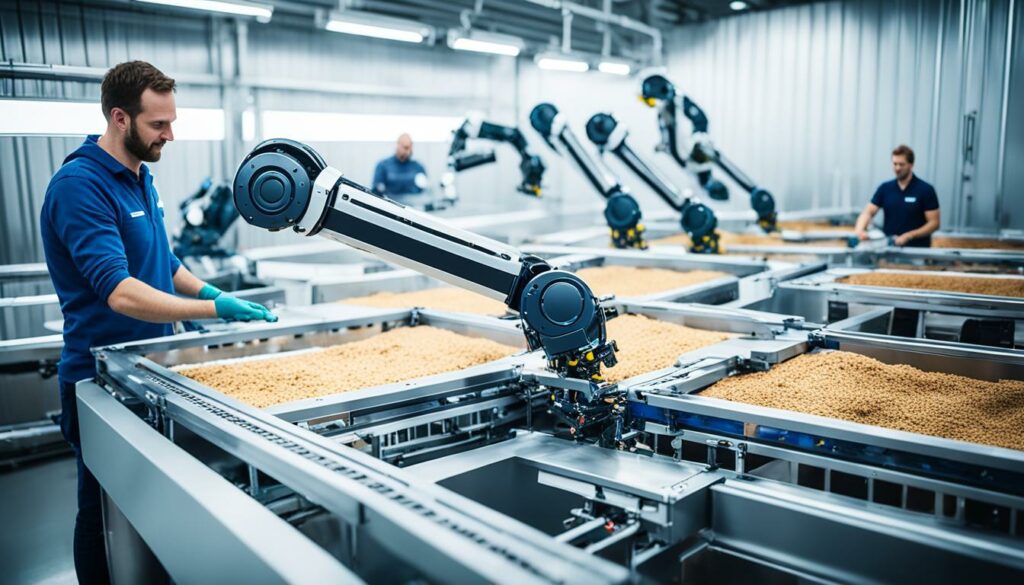
Robotics play a key role in the future of livestock farming. They address big problems like not having enough workers, high costs, and the welfare of the animals. With labour making up half of the costs in farming, the impact of not having enough workers is huge. Moreover, disease outbreaks are a real and ongoing threat. This means we need high-tech solutions for disease control.
Livestock Robotics Solutions offer many advantages. They make farming more efficient by cutting down on the need for people to do manual tasks. This not only saves time but also leads to better care for the animals.
For example, robotic milking and feeding systems ensure animals get what they need, when they need it, without any stress. This quality care doesn’t just help the animals; it also makes the environment cleaner. This is because using more robots and less manual labour can reduce harmful emissions and save resources.
In the cutting edge of farming today, we see innovative robotic solutions for animal care. These advancements boost efficiency and set higher standards for animal welfare. They play a key role in modern farming.
Robotic milking systems are changing the dairy world fast. They make milking more regular and give farm managers instant updates. This tech helps prevent mastitis, which costs over $6 billion each year in North America and Europe. It also aids in treating sick cows with a 70% success rate and boosting milk by 10%. SomaDetect’s system checks on cow health and milk quality to keep things running well.
Getting the food right is key in today’s farming. Automated feeders make sure animals get the right amount to eat, which cuts waste and tailors food for different needs. The BinSentry sensor saves money for feed producers and makes things run smoother. FarrPro and General Probiotics systems make food work better, lessen baby pig deaths, and fight off harmful germs, meaning less need for medicine.
Cleanliness matters a lot on farms. Robots are now scrubbing and sanitising, keeping animals in a healthier space. Faromatics’ ChickenBoy system looks after chickens’ surroundings and well-being too. All this work keeps away sickness and makes the farm cleaner.
These tech advancements are huge for farming. With robotic milking, feeding, and cleaning, farmers are moving towards a more eco-friendly and effective future.
Today, Precision Livestock Farming (PLF) is changing the game in agriculture. It uses the power of the Internet of Things (IoT) and data analytics. This helps farmers care for animals better and run their farms more smoothly. We’ll explore how PLF is making a difference in looking after livestock.
IoT has changed how farmers keep an eye on their animal herds. It includes automated estrus detection that many farmers are using now. This makes looking after animals easier and more effective. For example, automatic milking systems save time and make farm work more flexible for farmers.
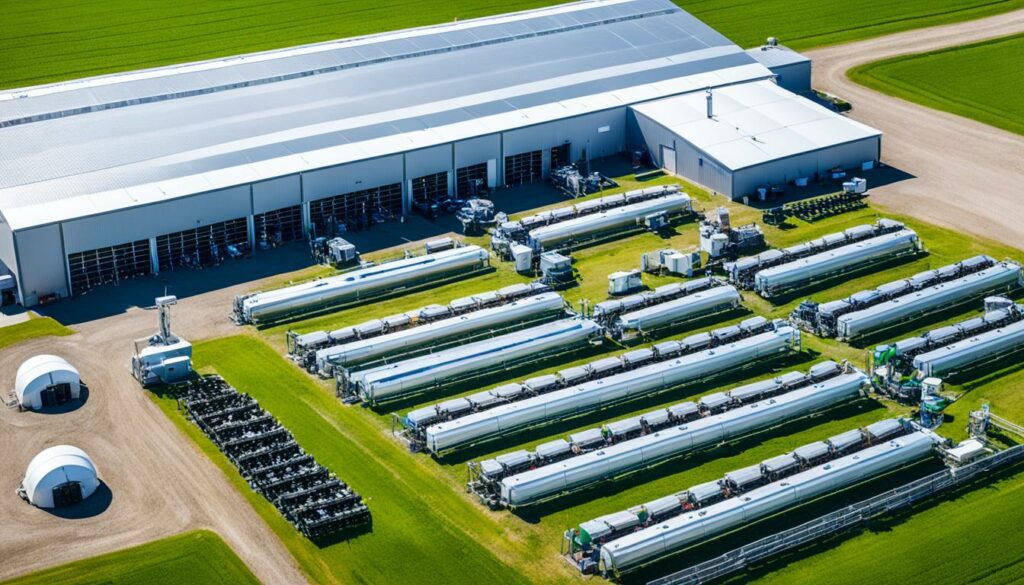
There are key tools like accelerometers for spotting when cows are in heat. But fewer tools are available to check for lameness. Geospatial and motion sensors are also vital. They help with tracking how animals move. This can give important clues to their health. Watching how animals walk can help spot problems early, improving their wellbeing.
Precision farming tools are great at keeping animals healthy. They let farmers watch their animals closely. This helps catch health issues early, preventing larger problems. By using these tools, farmers can make smart choices. This leads to a herd that’s both healthier and more productive.
| PLF Technology | Adoption Rate (%) | Benefits |
|---|---|---|
| Estrus Detection Systems | 48.6 | Improved breeding efficiency |
| Locomotion Monitoring | 0.2 | Early detection of lameness |
| Automatic Milking Systems | 43 | Increased labour efficiency |
In the end, Precision Livestock Farming is about using the best tech to look after animals. With IoT and Data Analytics, the approach is more efficient and ethical. It helps farmers manage livestock in ways that are good for both the animals and the environment.
Using robots is changing how we look after farm animals. Advanced tech is helping us spot and control diseases. This makes sure our animals are healthier and more productive.
Robots with smart sensors and AI are key in finding diseases early. They watch animal signs and actions all the time. This means they can pick up on any illness signs fast, letting us treat them early.
For example, picture-based systems can tell if pigs are healthy by looking at their weight. This helps give pigs the right care sooner, without using too many antibiotics.
Also, using high-tech for animal welfare is transforming farming. It makes finding diseases faster and helps stop them from spreading. This keeps herds safer from getting ill.
New tech like smart collars and ear tags is making a big difference. They have sensors that tell us how animals are doing in real time. This info includes their temperature, heart rate, and how much they move.
These gadgets help spot diseases and make sure animals are okay. They let farmers act quickly if something seems off. This helps keep animals healthy and makes farming more efficient.
So, using smart tech in farming can really improve how we care for animals. It makes farming better for the animals and for the planet.
Robotic herding systems are changing how we handle pastures. They automate moving and organising herds. This lets farmers control grazing better, improving pasture use and animal well-being with tech.

Mississippi State University’s Bearden Dairy Research Center shows off these tech’s potential. It gets 369,000 gallons of milk each year with only 200 cows. The Center for Advanced Vehicular Systems and Raspet Flight Research Lab tested the Clearpath Robotics Warthog UGV. It has cameras and sensors. The test showed animals can get used to these robots. This paves the way for future cow-herding tech.
Scientists are working on making rules for self-driving herding vehicles. The goal is to make Livestock Robotics Solutions a norm. They also want to get a U.S. Department of Agriculture grant. This shows their serious about changing how we manage livestock. UGVs can keep a close eye on animal health. This could lead to quick and good medical help for them.
Working with livestock, like herding cattle, can be tough and dangerous. But using robots can cut these risks and do the hard, repetitive work for us. This opens chances for teamwork between the livestock industry and tech experts. It leads to new jobs and careers in this changing field.
Scientists keep on looking into Robotic Herding Systems. They are devoted to making sure these techs work well in the farm world. These steps aren’t just about being better for the earth or the job. They change how we take care of our animals in a high-tech age.
In farming, AI Livestock Care is a big step forward. It brings predictive analytics to raise animals smarter. By using AI, farmers can make better, more predictive choices that boost the wellbeing of animals.
These new tools help with breeding, keeping animals healthy, and feeding them right. The use of AI means farmers can act ahead of time. This leads to more effective ways of raising animals. It also makes looking after them better for the animals.
AI in farming offers a new way to predict problems before they happen. For example, Cainthus’ technology watches how animals behave every day. And Rex Animal Health uses lots of data to offer smart solutions. These help guess what the animals might need. This makes running the farm smoother and more thoughtful.
Blockchain makes an unchangeable record of where animals come from and their health. This adds to the safety and trust in the food we eat. It makes the supply chain clearer for everyone. Combining it with AI in farming makes it even better.
AI and blockchain are changing farming. They make it more exact, efficient, and open. This can make raising animals better for everyone.
Robotics are changing how we breed animals in farming. They bring more accuracy to tasks like artificial insemination and embryo transfer. This means these jobs are done better and faster than before.
Robots are making a big difference in getting animals pregnant. They make sure the semen is placed exactly right, reducing mistakes. This ups the chance of success, beating doing it by hand every time. Studies like those in J Am Assoc Gynecol Laparosc. show robots do it better.
Using robots for embryo transfer makes the job smoother and more correct. As seen in J Laparoendosc Adv Surg Tech A., this leads to more pregnancies and better genetic results. Each step is done with high precision, which helps farm animals grow healthier and more diverse.
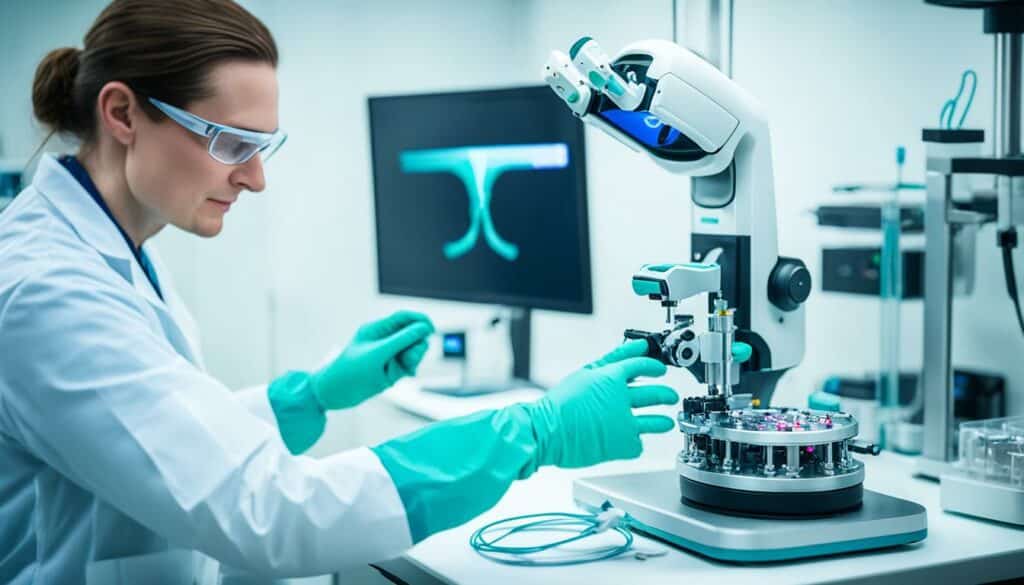
Robotic systems in farming improve the quality and genetics of herds. Research from Fertil Steril. and Hum Reprod. shows this clearly. Automating breeding means a more efficient and cost-effective farm.
These systems also help keep a close eye on every step, making sure things run smoothly. By using robots, farmers work better and help the environment. This approach is key to keeping up with the world’s need for animal products, all while caring for the animals.
Automated livestock care has big green benefits. It cuts down on resource use and lowers greenhouse gas emissions. Robotic systems make farming more efficient. They do this by being precise with feeding and managing waste. This helps reduce farming’s carbon footprint.
The Environmental Impact of Robotics shows it’s good for the planet. An example comes from Norway’s dairy farms. There, automated milking systems are making a difference. They changed how often cows are milked and what they eat, leading to less greenhouse gas. But, we need to be careful. Using these systems more might use up more energy. So, we should aim for a smart balance.
Resource Optimisation in Agriculture with robots is key. In Italy’s Upper Po Valley, they looked at this in dairy farms. They found that using the right feed systems can boost how much milk cows give. This means using high-tech methods for feeding can improve things a lot. It saves resources and makes farming more sustainable.
Using robots in farming does more than make it productive. It also helps Greenhouse Gas Reduction in Farming and keeps the industry green. These advanced systems aim for precision and efficiency. This is the path towards a nature-friendly and smart farming future.
Modern agriculture is leading the way with new tech, especially in livestock farming. At Montana State University in 1974, they started using electronic tags, a big step forward. This technology paved the way for smart farming robots we see today.
John Deere caught attention in 2018 with a self-driving tractor in the USA. In Switzerland, Ecorobotix’s weeding robot cut herbicide use by 90%. This led to 30% less spending on soil treatments. The USA’s Energid Technologies created a citrus harvesting system. It’s so efficient it picks fruits every 2-3 seconds.
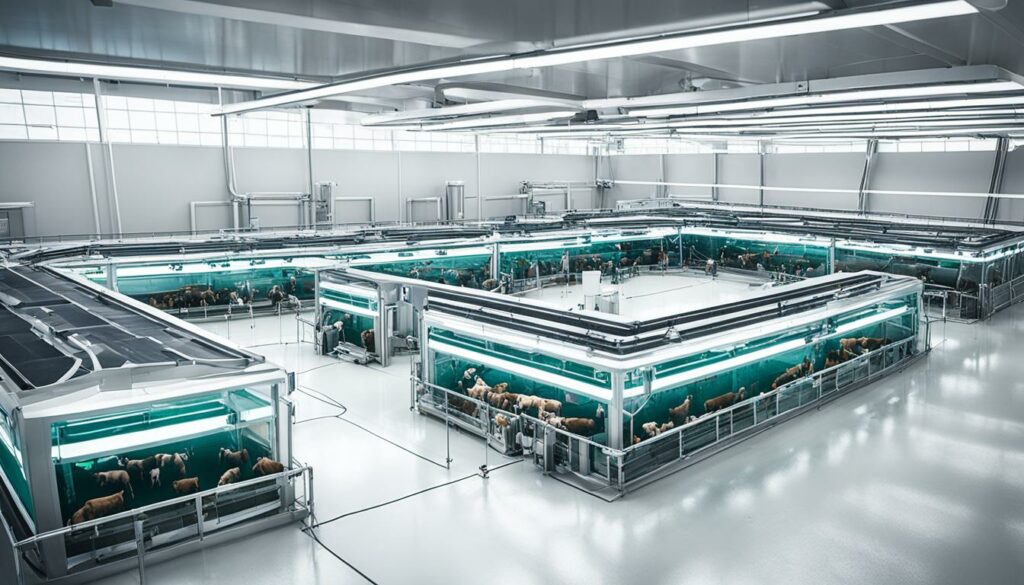
In 1992, the Netherlands’ Lely changed dairy farming with robotic milking. It helps farms with 100-300 cows and is especially good for improving workers’ lives. These systems save a lot of work and increase milk per cow, which is good for business. Big farms with over 1,000 cows are also starting to use this tech because of worker shortages.
| Company | Innovation | Impact |
|---|---|---|
| Montana State University | Electronic Tagging | Initiated in 1974 |
| John Deere, USA | Autonomous Tractor | Introduced in 2018 |
| Lely, Netherlands | Robotic Milking Systems | Improved productivity, enhanced working conditions |
| Ecorobotix, Switzerland | Weeding Robot | 90% reduction in herbicide use |
| Energid Technologies, USA | Citrus Harvesting System | Harvests every 2-3 seconds |
| Rogo Ag LLC, USA | SmartCore Soil Sample Collection Robot | Operates efficiently even in extreme conditions |
Rogo Ag LLC found that the SmartCore robot was twice as efficient as people. It can adjust to different farm needs. Also, using digital solutions has helped farmers increase their production by 57% in five years.
This data shows the real impact of smart farming tech in agriculture. It boosts productivity and brings big benefits for the economy and the environment. These examples show how automation is changing livestock farming for the better. They are shining examples for agriculture as a whole.
The Future of Livestock Care is closely linked to new tech. Emerging Technologies in Agriculture could change how we look after animals. They use data to offer better care and run farms more efficiently.
AI and Machine Learning are going to change how we care for animals. For example, Rex Animal Health uses AI to gather health and genetic info on animals. This info helps predict and stop diseases, leading to better crop results and happier animals.
Devices like wearable sensors on cows keep an eye on their activities and health. This gives farmers critical information to make better choices.
Drones and UAVs are becoming important in looking after animals better. They give a wide view of the farm, which is great for keeping an eye on animals. CattleEye has an innovative system to watch over animals using drones.
This technology makes it easier to manage pastures. It ensures cows eat well and get health checks when needed.
These Emerging Technologies in Agriculture make farming more efficient and kind to animals. Soon, more dairy farms will use robots. This will change the farming industry a lot and lead to better care for livestock.
| Technology | Company | Impact |
|---|---|---|
| AI and Machine Learning | Rex Animal Health | Optimises yields, prevents diseases |
| Drones and UAVs | CattleEye | Enhances monitoring and pasture management |
| Wearable Sensors | General Probiotics | Tracks daily activities, improves health management |
Using Animal Welfare Technology in farming is a big step for animal care. Robotic systems help improve conditions and are becoming more common. They are key to making sure farm animals are looked after well and with kindness.
In the US, the dairy industry is worth more than $30 billion. There are about nine million dairy cows there. Technology like biometric sensors and analysis help spot sickness early. It also shows how to make things better. This tech checks the animals’ health and behaviour all the time. This makes them healthier and more productive.
Investors are putting more money into making technology for animals. Companies like Cainthus and Rex Animal Health are leading this area. They focus on stopping diseases and understanding animal genes better. By doing this, they are making the future of farming more ethical and better.
New tech that doesn’t bother animals, like smart collars, is becoming more common. These tools help take care of animals without causing them stress. They provide regular and detailed care. This makes animals both physically and mentally better.
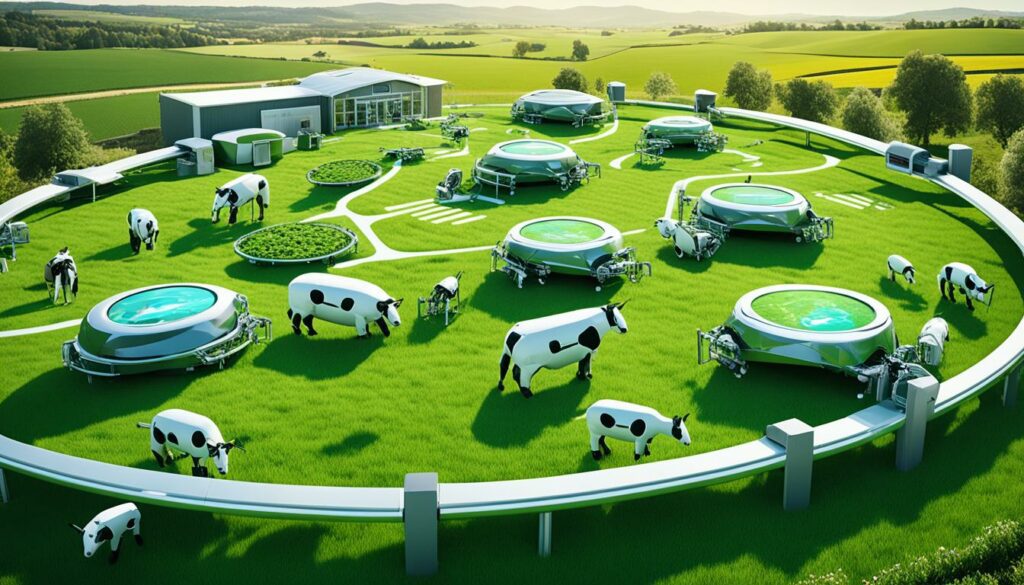
This technology lets cows act more naturally. It also turns data into advice. This advice helps farmers make better decisions. New technology in farming over the last decade has shown great results.
Advances in machine vision and wearable sensors are very helpful. They make sure farms meet their financial goals and care for animals right.
With Animal Welfare Technology, the farming industry is heading towards a more caring and effective future. It’s making sure farms are both humane and productive. It puts the way we treat animals at the heart of farming.
The livestock industry is on the brink of a big change, all thanks to robots. There are many hurdles to overcome to fully enjoy the benefits. I’ll cover the main issues and how we might solve them in this piece.
High costs are a top issue when it comes to livestock robotics. Today, about 12% of dairy farms use robots. This number is set to climb to 20% in the next five years. To get there, farms will have to invest a lot in these smart technologies. Making it easier for farmers to afford these setups is key. Things like flexible payments or help from the government could make a big difference, especially for smaller farms.
New technologies mean farmers need to learn more. Livestock tech has come a long way in eight to ten years. But, without understanding how to use these new tools, their full potential won’t be realised. This is where Education and Training in Smart Farming steps in. It offers farmers courses on using sensors, checking milk production in real time, and managing animal health with data.
Not all farms are ready for the jump to high-tech robots. Ensuring robots work smoothly even in older farms is tough. A tech solution like Cainthus’ animal health and productivity monitoring is hard to fit into old layouts. But, with adjustments and upgrades, we can make it work. This way, farms won’t have to change everything at once, avoiding big interruptions.
By tackling these challenges, the livestock field can make the most of robotics. This could make looking after animals more efficient, sustainable, and backed by solid data.
Introducing robotics in farming has changed how we see agriculture. It makes tasks automatic and uses smart systems to watch over everything. This lifts farming to new heights in terms of how well it runs and how it treats the environment. Looking at where we’re heading, it’s clear that robotics in agriculture will play a big role in the future.
In precision farming, a better way has been found to guess how much pigs weigh live. Also, there’s technology to measure how much food they’re eating in their space. These changes are big for how farming is done. They make sure the animals are doing well in places where they are kept tightly. Nature studies show that how animals act and feel is mostly about where they live, not just how much space they have.
Today, animal technology keeps getting better. One cool thing is robots checking the air in the barn. This is all about making sure farming is always good for the animals and the planet. These steps forward don’t just fix problems now. They’re making a way for farming to be smart, kind, and careful with nature in the future.
The livestock farming industry is vital, making up around 40% of global agricultural GDP. As of 2020, the world produced 335.4 million tons of meat, worth USD 1,329.1 million financially. It must now meet food demands sustainably and ethically for a growing population expected to hit 9.5 billion by 2050.
Traditional livestock methods, including feeding and healthcare, are now outdated. This manual approach is struggling with the demands of today. It faces problems like not enough workers, high production costs, and it’s hard to control diseases. Environmental harm is another huge issue.
The world is running out of resources and there’s not enough workers in the field. The livestock industry must find ways to keep up, without causing harm. Technologies like robotics offer efficient solutions. They make management easier, take better care of the animals, and cut down costs.
Robots make looking after animals easier and more efficient. They help control diseases better and cut the costs of running a farm. They also use resources wisely and lessen greenhouse gas emissions, helping the environment.
Robotic milking ensures every cow gets milked regularly, and farmers always know how their herd is doing. This way, the farm runs more efficiently, improving the lives of the cows and the farmers. It also keeps better health records for the cows.
Automated feeding systems make sure the animals get just the right amount of food. They cut waste and make sure each group of animals gets the diet they need. This keeps the animals healthy.
Robots clean up animal messes and keep the area sanitized. They make the living space healthier for the animals, all automatically. This improves hygiene for the livestock, without farmers having to do it all themselves.
Precision Livestock Farming uses tech to closely watch over animal health and behaviour. With tools like sensors, it’s easier to spot when something is wrong. This helps make better decisions about the animals.
Robots have made a big difference in fighting diseases. They wear smart collars and ear tags to keep an eye on health all the time. They help find problems early and stop diseases spreading, keeping all the animals safer.
Robots help organise where animals graze, using GPS and virtual fences. This keeps pastures in good condition and keeps the animals from getting too stressed. Pastures are used better and animals are happier.
AI can predict when animals will need care, what they should eat, and how they will grow. This helps plan ahead. With blockchain, we can also track animals’ health and history clearly, making the whole farm run smoother.
Robots are making breeding more precise and more successful. They help with artificial insemination and embryo transfer to get the best results. This improves animal genetics and how farms breed their livestock.
Using robots can help the environment by cutting greenhouse gases and managing resources better. They are key in reducing the harm that farming can do to our planet.
There are many stories of successful farms thanks to using tech. These cases show that technology is not just good for the earth, but also for the animals and the business of farming.
AI and machine learning are changing how farms are managed, making predictions more accurate. Drones are also becoming important for watching over animals and making farming more efficient.
By taking care of daily tasks, robots provide a stable and gentle environment for the animals. They ensure good care without bothering the animals. This supports kind treatment and helps follow welfare guidelines.
Teaching smaller farms to use this tech can be tricky, mainly because of the costs. It’s also important to train farmers to use these new tools well. Making sure they fit in with current farm systems is essential too.